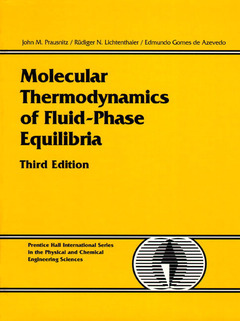Description
Molecular Thermodynamics of Fluid-Phase Equilibria (3rd Ed.)
Authors: Prausnitz John, de Azevedo Edmundo Gomes, Lichtenthaler Rudiger
Language: English
160.72 €
Subject to availability at the publisher.
Add to cart896 p. · 10x10 cm · Hardback
Description
/li>Contents
/li>Comment
/li>
The classic guide to mixtures, completely updated with new models, theories, examples, and data.
Efficient separation operations and many other chemical processes depend upon a thorough understanding of the properties of gaseous and liquid mixtures. Molecular Thermodynamics of Fluid-Phase Equilibria, Third Edition is a systematic, practical guide to interpreting, correlating, and predicting thermodynamic properties used in mixture-related phase-equilibrium calculations.
Completely updated, this edition reflects the growing maturity of techniques grounded in applied statistical thermodynamics and molecular simulation, while relying on classical thermodynamics, molecular physics, and physical chemistry wherever these fields offer superior solutions. Detailed new coverage includes:
- Techniques for improving separation processes and making them more environmentally friendly.
- Theoretical concepts enabling the description and interpretation of solution properties.
- New models, notably the lattice-fluid and statistical associated-fluid theories.
- Polymer solutions, including gas-polymer equilibria, polymer blends, membranes, and gels.
- Electrolyte solutions, including semi-empirical models for solutions containing salts or volatile electrolytes.
Coverage also includes: fundamentals of classical thermodynamics of phase equilibria; thermodynamic properties from volumetric data; intermolecular forces; fugacities in gas and liquid mixtures; solubilities of gases and solids in liquids; high-pressure phase equilibria; virial coefficients for quantum gases; and much more.
Throughout, Molecular Thermodynamics of Fluid-Phase Equilibria strikes a perfect balance between empirical techniques and theory, and is replete with useful examples and experimental data. More than ever, it is the essential resource for engineers, chemists, and other professionals working with mixtures and related processes.
1. The Phase Equilibrium Problem.
2. Classical Thermodynamics of Phase Equilibria.
3. Thermodynamic Properties from Volumetric Data.
4. Intermolecular Forces, Corresponding States and Osmotic Systems.
5. Fugacities in Gas Mixtures.
6. Fugacities in Liquid Mixtures: Excess Functions.
7. Fugacities in Liquid Mixtures: Models and Theories of Solutions.
8. Polymers: Solutions, Blends, Membranes, and Gels.
9. Electrolyte Solutions.
10. Solubilities of Gases in Liquids.
11. Solubilities of Solids in Liquids.
12. High-Pressure Phase Equilibria.
Appendix A. Uniformity of Intensive Potentials as a Criterion of Phase Equilibrium.
Appendix B. A Brief Introduction to Statistical Thermodynamics.
Appendix C. Virial Coefficients for Quantum Gases.
Appendix D. The Gibbs-Duhem Equation.
Appendix E. Liquid-Liquid Equilibria in Binary and Multicomponent Systems.
Appendix F. Estimation of Activity Coefficients.
Appendix G. A General Theorem for Mixtures with Associating or Solvating Molecules.
Appendix H. Brief Introduction to Perturbation Theory of Dense Fluids.
Appendix I. The Ion-Interaction Model of Pitzer for Multielectrolyte Solutions.
Appendix J. Conversion Factors and Constants.
Index.
- NEW - Expands discussion of the theoretical concepts used to describe and interpret solution properties. Pg.___
- NEW - Now covers models such as the lattice fluid theory and the statistical associated fluid theory (SAFT). Pg.___
- NEW - Offers a new chapter on polymer solutions that includes discussions of gas-polymer equilibria at ordinary and high pressures, polymer blends, polymeric membranes, and gels. Pg.___
- NEW - Includes new material on osmotic pressure and Donnan equilibria. Pg.___
- NEW - Contains a new chapter on electrolyte solutions that presents the thermodynamic basis for describing activities of components in electrolyte solutions and gives theoretical and semi-empirical models that have been developed for electrolyte solutions. Pg.___
- NEW - Adds updated examples and new problems. Pg.___
- Offers clear presentation of difficult subjects that enables students to apply difficult concepts. Pg.___




